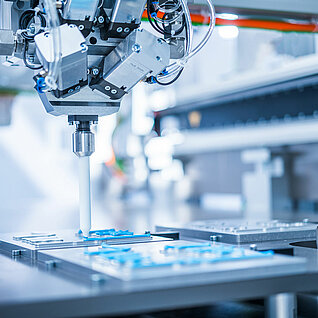A central approach to effectively dissipate this heat is to use fluid thermal interface potting compounds such as gap fillers or thermally conductive adhesives. They contain special fillers that provide for reliable heat dissipation in the component. Thermally conductive fluids can be found in household appliances as well as in standard smartphones, tablets and LED lighting. They are also used in engine production, power electronics and battery systems in hybrid and electric vehicles.
Compared to solid, stamped pads or film for dissipating heat, thermally conductive fluids make it possible to apply custom contours onto the component. Users also benefit from improved performance, since usually they have higher thermal conductivity than solid materials. During the assembly process, the fluid materials such as gap fillers or thermally conductive adhesives flexibly adapt to the particular substrate surface. Particularly sensitive electrical components are thus less exposed to assembly stress, dramatically reducing the risk of defective goods. Reduced storage costs as well as reduced or even entirely eliminated handling and assembly costs are additional advantages.


